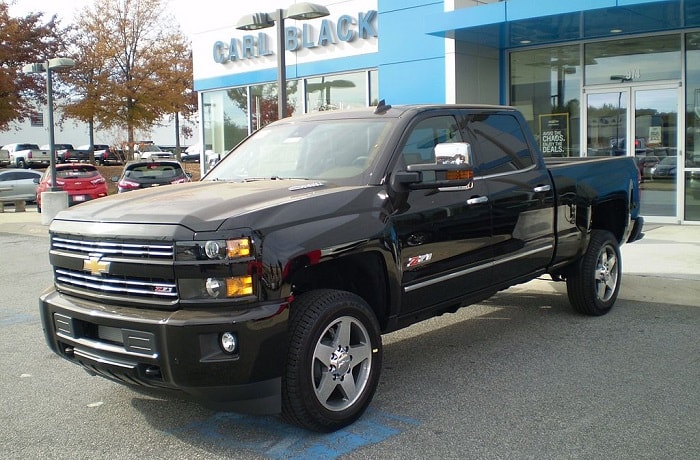Thinking about leveling your Chevy Silverado 2500HD to improve its look and fit larger tires? While it might seem like a significant upgrade, there are some issues you’ll want to know about first.
From faster suspension wear to alignment problems, these modifications can affect your truck’s performance and handling.
But don’t worry—by knowing the potential drawbacks, you can choose wisely and avoid surprises. Let’s break down what you need to watch for when installing a leveling kit.

1. Suspension Component Wear
A common issue among Chevy 2500HD owners who install leveling kits is premature suspension wear. Leveling kits change the suspension’s geometry, putting added strain on components like ball joints, control arms, and tie rods.
These parts are designed for the truck’s factory height, and the new angles at which they must operate after a lift cause faster wear and tear.
Owners of 2015-2022 models have noted that suspension components, especially in the front, wear out faster after a leveling kit is installed—particularly with lifts over 2 inches.
Some drivers report needing to replace ball joints and control arms as early as 10,000 to 15,000 miles after installation, which can lead to mounting repair bills.
Trucks used for towing or off-road driving are especially prone to these issues, as the additional strain worsens the wear on these parts.
2. Alignment and Tire Wear Problems
Another issue with leveling kits on the Chevy 2500HD is alignment. Raising the front of the truck throws off the alignment, leading to uneven tire wear. Many owners find their trucks pulling to one side, even after multiple alignment attempts.
This misalignment results from the altered suspension geometry, which makes it harder to keep the wheels within the original factory specifications. Chevy 2500HD models from 2015 to 2022 seem prone to alignment challenges after a lift.
Uneven tire wear, especially on the inside edges, is a common symptom, leading to faster tire replacements, poorer handling, and decreased fuel efficiency.
3. CV Axle and Driveshaft Wear
Installing a leveling kit can also cause problems with the CV axles and driveshafts, particularly in lifted trucks used for off-road adventures or heavy towing. Raising the front of the truck changes the angles at which these components operate, leading to premature wear.
Drivers with lifts over 2 inches frequently report issues with CV axles, including clicking sounds, vibrations, or outright failures within 10,000 to 15,000 miles of installation—especially in 2016-2022 models.
Also, driveshaft problems often emerge, with owners noticing vibrations during acceleration or while carrying heavy loads.
The altered drivetrain angles are usually the cause, and if left unaddressed, these vibrations can result in long-term damage to the driveshaft and other components.
3. Rougher Ride and Reduced Handling
Although leveling kits improve the Chevy 2500HD’s stance, they can degrade ride quality. Many drivers report a rougher, less comfortable ride after installation, with increased body roll and reduced stability, especially at highway speeds or uneven roads.
The rougher ride is often due to the stiffer springs in many leveling kits. These stiffer springs limit the truck’s ability to absorb bumps and vibrations, making it feel less smooth and more unsettled.
Also, raising the front of the truck changes its center of gravity, making it more prone to body roll during sharp turns or sudden maneuvers.
Models from 2015 to 2022 are particularly affected, with drivers of trucks lifted over 2 inches frequently commenting on the reduced ride quality.
4. Brake System Strain
Larger tires, often added alongside leveling kits, can put extra strain on the Chevy 2500HD’s braking system. The increased rotational mass makes it harder for the brakes to perform as efficiently, leading to longer stopping distances and faster wear on the brake pads.
Many owners who install leveling kits report decreased brake responsiveness, particularly when towing or hauling heavy loads.
Some have even experienced spongy brakes after adding larger tires without upgrading other components. The kit can sometimes cause tension on the brake lines, reducing braking performance or damaging the lines over time.
5. Added Strain on Steering Components
Leveling kits can also lead to additional strain on steering components, like the pitman arm, idler arm, and steering rack. The larger tires and altered suspension geometry force these parts to work harder, leading to faster wear and potential failure.
Drivers of 2015-2022 models commonly report looser, less precise steering after installing a leveling kit. The truck may feel harder to control, especially at higher speeds or when towing.
In some cases, steering components fail prematurely, necessitating expensive replacements. The increased load on the steering system can also create safety concerns, making it more challenging to handle the truck in emergencies.
6. Warranty and Dealer Refusals
One primary consideration for Chevy 2500HD owners considering installing a leveling kit is the potential impact on the vehicle’s warranty. Many drivers have difficulties getting warranty service after installing a kit, particularly for suspension, steering, or drivetrain issues.
Dealers often refuse to cover these repairs under warranty, citing the leveling kit as the cause—even if the problem seems unrelated.
Some owners have found that the modification voids certain aspects of the factory warranty, leaving them responsible for costly repairs. For those still under warranty, weighing before modifying the truck is essential.
Conclusion
While a leveling kit can improve the appearance and off-road capability of your Chevy 2500HD, you need to know the potential downsides.
These modifications can significantly affect your truck’s performance and reliability, from increased suspension and steering wear to alignment and braking issues.
It is essential to consider the possible warranty impacts and long-term maintenance costs. If you rely on your truck for heavy-duty tasks or long-distance driving, carefully weigh the benefits and risks before installing a leveling kit.
Was This Article Helpful?

